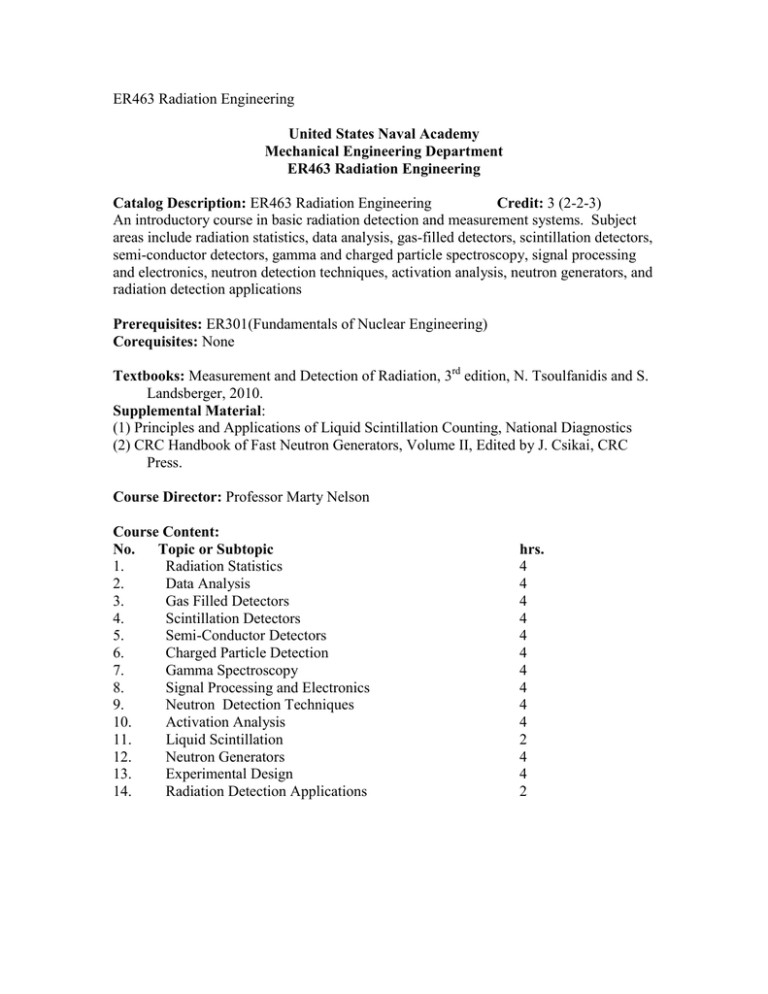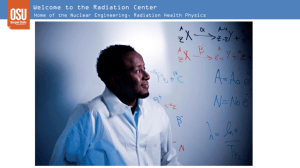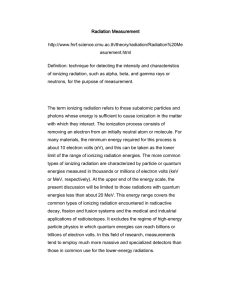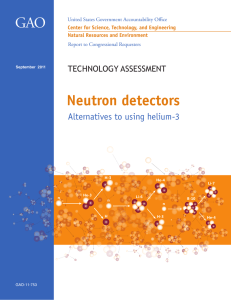ER463 Radiation Engineering United States Naval Academy Mechanical Engineering Department
advertisement

ER463 Radiation Engineering United States Naval Academy Mechanical Engineering Department ER463 Radiation Engineering Catalog Description: ER463 Radiation Engineering Credit: 3 (2-2-3) An introductory course in basic radiation detection and measurement systems. Subject areas include radiation statistics, data analysis, gas-filled detectors, scintillation detectors, semi-conductor detectors, gamma and charged particle spectroscopy, signal processing and electronics, neutron detection techniques, activation analysis, neutron generators, and radiation detection applications Prerequisites: ER301(Fundamentals of Nuclear Engineering) Corequisites: None Textbooks: Measurement and Detection of Radiation, 3rd edition, N. Tsoulfanidis and S. Landsberger, 2010. Supplemental Material: (1) Principles and Applications of Liquid Scintillation Counting, National Diagnostics (2) CRC Handbook of Fast Neutron Generators, Volume II, Edited by J. Csikai, CRC Press. Course Director: Professor Marty Nelson Course Content: No. Topic or Subtopic 1. Radiation Statistics 2. Data Analysis 3. Gas Filled Detectors 4. Scintillation Detectors 5. Semi-Conductor Detectors 6. Charged Particle Detection 7. Gamma Spectroscopy 8. Signal Processing and Electronics 9. Neutron Detection Techniques 10. Activation Analysis 11. Liquid Scintillation 12. Neutron Generators 13. Experimental Design 14. Radiation Detection Applications hrs. 4 4 4 4 4 4 4 4 4 4 2 4 4 2 Assessment Methods: A B C D E F G H I Quizzes Homework Exams Laboratory Reports Oral Presentations Design Reports/Notebooks Prototypes/Demonstrations Projects Other YES X X X X X X NO X X X 1 Course Outcomes : 1. Students will demonstrate an understanding and solve problems associated with radiation detection systems including gas filled detectors, scintillation detectors, semi-conductor detectors and charged particle detectors. (A,B,C,D) 2. Students will demonstrate an understanding and solve problems associated with neutron detection and activation analysis. (A,B,C,D) 3. Students will demonstrate an understanding and solve problems associated with signal processing for gamma and charge particle spectroscopy. (A,B,C) 4. Students will demonstrate an understanding and solve problems associated with applications of radiation detection systems. (A,B,C) 5. Students will demonstrate the ability to use statistical methods to solve radiation engineering problems. (A,B,C,D) 6. Students will demonstrate the ability to collect data and analysis experimental results. (D,E) 7. Students will demonstrate the ability to clearly present laboratory results and design projects in written and oral reports.(D,E,F,H) 8. Students will demonstrate the ability to contribute to laboratory and design teams. (D,E,F,H) 1 Letters in parenthesis refer to the assessment methods listed in previous section. Program Outcomes (a) (b) (c) (d) (e) (f) (g) (h) (i) (j) (k) (1) (2) (3) √ √ √ √ √ √ (4) (5) (6) √ √ √ √ (7) (8) √ √ √ √ √ √ √ √ √ √ √ √ √ √ √ √ √ √ √ √ √ √ √ √ √ √ √ √ √ √ √ √ √ √ √ Date of Latest Revision: 14 Nov 2012 √






